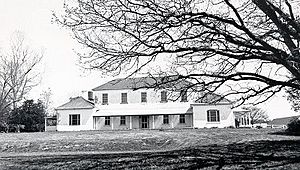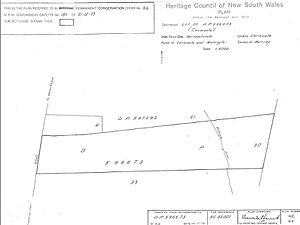Carwoola Homestead facts for kids
Quick facts for kids Carwoola Homestead |
|
|---|---|
 |
|
| Location | 1071 Captains Flat Road, Carwoola, Queanbeyan-Palerang Region, New South Wales, Australia |
| Built | 1830–1850 |
| Owner | Carwoola Pastoral Co Pty Ltd |
| Official name: Carwoola Homestead | |
| Type | state heritage (built) |
| Designated | 2 April 1999 |
| Reference no. | 36 |
| Type | Homestead Complex |
| Category | Farming and Grazing |
| Builders | William and Thomas Rutledge |
| Lua error in Module:Location_map at line 420: attempt to index field 'wikibase' (a nil value). | |
Carwoola Homestead is a very old and important group of buildings located at 1071 Captains Flat Road in Carwoola, New South Wales, Australia. It was built between 1830 and 1850 by William Rutledge and later by his brother Thomas Rutledge. This historic site is now protected and was added to the New South Wales State Heritage Register on 2 April 1999.
Contents
Discovering Carwoola's Past
The land where Carwoola Homestead stands was first explored by botanist Allan Cunningham in 1824. He called the area Marley's Plains. Later, in 1828, a large piece of land (about 1036 hectares) was given to Henry Gilbert Smith. He started the Carwoola station.
The name "Carwoola" has been used since at least 1850. It might come from an Aboriginal word, "Carrowillah." This word is thought to mean "the meeting of the waters on the plain." This makes sense because Carwoola is on flat land near the Molonglo River, which has many streams flowing into it.
Early Buildings and Owners
The very first buildings at Carwoola were small slab dwellings. These were built by Edward John Eyre, who later became a famous explorer. He bought some land from Henry Gilbert Smith in 1834.
In 1836, William Rutledge bought the land from Smith. He also bought Eyre's blocks in 1837. The main buildings you see today were built by William and Thomas Rutledge in the late 1830s.
The Rutledge Family's Influence
In 1839, William's brother, Thomas Rutledge, came to Australia and became the manager of Carwoola. He was quite young, in his early twenties. Thomas later bought Carwoola and became its owner. William Rutledge moved to Victoria.
The Rutledge brothers slowly bought more land. By the 1870s, they owned about 36,450 hectares. Carwoola became a very important place in the area. It was known for its welcoming atmosphere and helped many nearby settlers and travelers. The homestead was described as being "of the modern style" and had a store, post office, and telegraph office.
Thomas Rutledge was known for being very kind and generous. He was also famous for breeding fast racehorses. He passed away in 1904 at 86 years old. Thomas and his wife, Martha, are buried in the graveyard of St. Thomas' Anglican Church. This church was built on land Thomas donated and was finished in 1874.
At its busiest time, between 80 and 100 people lived and worked at Carwoola. There were special living areas for married and unmarried workers.
Later Owners and Changes
In 1907, Carwoola was sold to James Maslin from South Australia. At that time, the station was still very large, about 16,200 hectares, and had 12,000 sheep. James Maslin's son, Jim, was killed in France during World War I in 1917. A window in St. Thomas's Church remembers him.
By 1928, James Maslin had made the property even bigger, to about 25,778 hectares. But then, it was divided and sold off in seven smaller parts. The main homestead block was described as a beautiful stone house with "palatial" (very grand) outbuildings. It had modern features like water, electricity, and sewerage.
In 1929, the homestead was described as a "comfortable two-storied stone building" with 16 rooms, including a billiard room. It also had lovely gardens with English trees like elm and oak.
The Scott family owned Carwoola from the 1920s until 1972. In 1979, the owner asked for the property to be protected. Because of its history and beauty, Carwoola Homestead was officially listed on the New South Wales State Heritage Register on 2 April 1999.
Exploring Carwoola Homestead
Carwoola is an old colonial homestead with many different buildings. These buildings are set in a beautiful rural landscape with both natural and man-made features. It's important because it shows how early farms developed and succeeded.
In 1866, Carwoola was called "the model farm Par Excellence of NSW" because it was so complete. Today, the farm is about 5000 acres (2023 hectares).
The Main House
The main house has two stories in the middle. On each side, there are single-story wings that stick out to form a veranda. At the back, two stone wings create a sheltered courtyard. Around this courtyard are many old outbuildings. These include a stone hayshed, stone stables, stone worker cottages, and a slab hut and stables. The main house looks strong, simple, and impressive.
The front of the house looks very grand. The central two-story part has two main rooms downstairs and three bedrooms upstairs. The front door opens into a hall with a nice staircase. To the right is a large sitting room with a beautiful white marble fireplace. To the left is the dining room. The doors, windows, and original fireplaces are made of fine red cedar wood.
Throughout the house, you can see beautiful cedar woodwork, six-panel doors, and large windows. The windows in the side wings have special extra side lights and cedar shutters that fold into the walls.
Other Buildings Around the Homestead
There are many other buildings at Carwoola, built between 1830 and 1850. Most are made of local stone and were originally painted white. These outbuildings are interesting not just for their old style but also for how they are grouped together in the garden.
- Stone Block: This building is very striking. It has a meat room, a coach house, two sets of two rooms, a cell with a barred window, and an old kitchen with a stone floor. Behind it, a very long stone wall protects the remains of a kitchen garden.
- Stone Stables: Near the stone block, there's a very large stone building that was used as stables for horses.
- Slab Stables: This building has horse stalls made of vertical wooden slabs set on large horizontal logs.
- Slab Shed: Beyond the slab stables, there's another slab building that might have been a salt shed.
- Barn: This barn is made of thick rubble stone walls, about 0.6 meters (2 feet) thick. It has large openings for hay wagons pulled by horses.
- Blacksmith's Shop: This two-story slab building was used as a blacksmith's shop and coach house. Its strong wooden posts are charred black to protect them from termites.
- Cottages: Some old cottages near the homestead are now part of newer additions.
- Shearing Shed: This shed is on the other side of the entrance driveway, along with a small stone house.
Gardens and Yards
The homestead is reached by a long driveway lined with oak trees. There's also a large pond at the front of the house.
The gardens have many old trees like oaks and elms. These trees let sunlight in during winter, allowing spring flowers like daffodils and jonquils to grow below. In summer, you can see roses and lavender. There's also a large Bunya pine tree. Newer plants include crab apples, winter honeysuckle, and Japanese quince.
North of the main buildings, there's a large vegetable garden that provides food all year. An old walnut and mulberry tree grow near tall brick walls. There are also apple trees and a chicken house.
Why Carwoola Homestead is Important
Carwoola is a significant early colonial homestead. It has many old buildings set in a beautiful rural landscape. The homestead and its outbuildings were built between 1830 and 1850. The main house has a strong and simple design, while the other buildings are interesting for their traditional styles and how they are arranged in the garden.
The site is important because it shows how people lived and farmed in early New South Wales. It was a central place for people to gather and be welcomed in the district during the late 1800s.
Carwoola Homestead was added to the New South Wales State Heritage Register on 2 April 1999 because:
- It shows important history: The homestead and its buildings were built between 1830 and 1850. It was a key place for social life and farming in the region during the 19th century.
- It has beautiful design and skill: Carwoola is an early colonial homestead with many old buildings in a lovely rural setting. The main house has a strong and simple design. The other buildings are important examples of old building styles and create interesting groups within the impressive garden.


